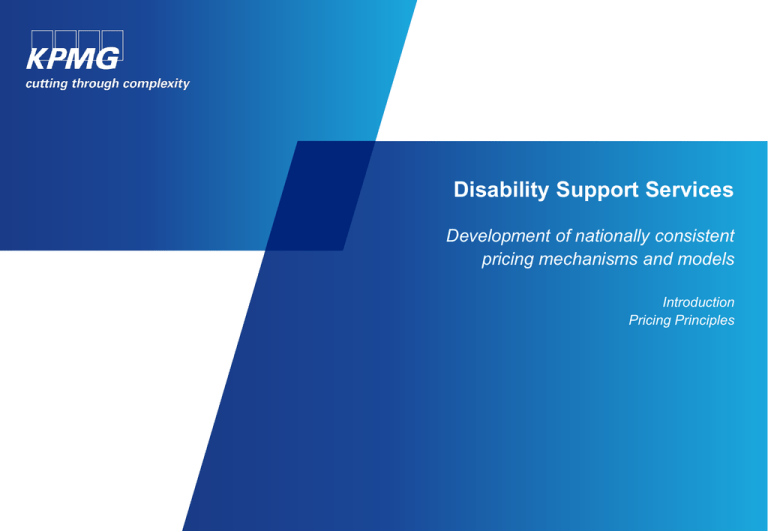
Disability Support Services
Development of nationally consistent
pricing mechanisms and models
Introduction
Pricing Principles
Disability Support Services
Development of nationally consistent pricing
mechanisms and models
Agenda
Project objectives and scope
Agenda
10:00
Welcome and Introductions
10:15
Ministry of Health – Project Background and Scope
10:30
Project Outline, Methodology, Scope and Timelines
10:50
Background to the development of Pricing Principles
11:10
Questions
11:20
Break
11:40
Workshop Instructions – Presentation of ‘Strawman’
11:50
Workshop / Table Discussions
12:20
Group Feedback
12:40
Summary and Reflections
12:50
Next Steps and Close
© 2013 KPMG, a New Zealand partnership and a member firm of the KPMG network of independent member firms affiliated with KPMG International Cooperative
(“KPMG International”), a Swiss entity. All rights reserved. Printed in New Zealand.
2
Project objectives
Project objectives
To develop nationally consistent pricing methodologies and pricing models for selected
Disability Support Services
■ To result in:
• Service delivery equity and clarity for service users
• Price equity and clarity for providers
• Sustainable and efficient high quality disability support services, and
• Transparency for DSS regarding value for money.
© 2013 KPMG, a New Zealand partnership and a member firm of the KPMG network of independent member firms affiliated with KPMG International Cooperative
(“KPMG International”), a Swiss entity. All rights reserved. Printed in New Zealand.
3
Project Scope
Pricing mechanisms and models will be developed for the following suite of
services:
■ Child Development Services
■ Assessment, Treatment & Rehabilitation
■ Home and Community Support Services
■ Respite
■ Carer Support
■ Supported Independent Living
■ Community Residential Living (includes High and Complex)
© 2013 KPMG, a New Zealand partnership and a member firm of the KPMG network of independent member firms affiliated with KPMG International Cooperative
(“KPMG International”), a Swiss entity. All rights reserved. Printed in New Zealand.
4
Purpose of today
■ Project introduction and background
■ Outline the approach to pricing
■ Discuss the project methodology and timeframes
■ Provide an indication of the level of sector involvement and consultation required
■ Seek input into the fundamental principles that will underpin the pricing methodologies and models
(Pricing Principles)
© 2013 KPMG, a New Zealand partnership and a member firm of the KPMG network of independent member firms affiliated with KPMG International Cooperative
(“KPMG International”), a Swiss entity. All rights reserved. Printed in New Zealand.
5
Disability Support Services
Development of nationally consistent
pricing mechanisms and models
Approach to pricing
Approach to Pricing
Pricing Principles (today)
Service Descriptions
• Develop the basis under which pricing mechanisms and prices will
be determined
• Ensure common understanding and agreement as to how
services are described and counted
Develop data collection tool
• Review data availability and quality and develop data collection
tool
Data Collection
• Sector wide data collection to identify costs of service delivery
Approach to pricing
Setting prices and implementation
planning
• Review contemporary approaches to pricing and consider
suitability in the NZ context
• Set prices and develop and implementation and management
plan
© 2013 KPMG, a New Zealand partnership and a member firm of the KPMG network of independent member firms affiliated with KPMG International Cooperative
(“KPMG International”), a Swiss entity. All rights reserved. Printed in New Zealand.
7
Approach to Pricing
Pricing Principles
■ Develop a set of principles with input from the service sector and Reference Network
■ Establish the ‘market rules’ that define the scope of pricing and what it is intended to cover
■ Help to define the relationship between the purchaser and the recipient of funds (service providers) in
relation to the use of prices
■ Ensure that the values and expectations of DSS providers are recognised, which will ultimately
influence the design of the pricing approach
These will be addressed further in today’s workshop
© 2013 KPMG, a New Zealand partnership and a member firm of the KPMG network of independent member firms affiliated with KPMG International Cooperative
(“KPMG International”), a Swiss entity. All rights reserved. Printed in New Zealand.
8
Approach to Pricing
Service Descriptions
■ Service Activity
• Review service specifications
• Collect information on how services are delivered, measured and counted
• Review service activity and performance reports
• Consider variations between regions and providers
• Consider variations resulting from nature of disability, complexity and individual preferences
• Develop an understanding of service outputs and outcomes
• Review Ministry targets / expectations as part of contracts or service agreements
■ Cost Drivers
• Identify cost drivers during discussions with a mix of different providers
• Discuss the historical impact of these drivers
• Consider how these may be assessed during the analysis of costing information
© 2013 KPMG, a New Zealand partnership and a member firm of the KPMG network of independent member firms affiliated with KPMG International Cooperative
(“KPMG International”), a Swiss entity. All rights reserved. Printed in New Zealand.
9
Approach to Pricing
Service Descriptions
■ Financials
• Assess the availability of financial data from a sample of organisations and the Ministry
• Review financial reporting systems and identify commonalities and differences between providers
• Form a view as to the depth, availability and quality of financial data likely to be provided
• Consider ways to identify and capture the impact of known (and unknown) cost drivers
• Consider the implications for the development of an approach to pricing
■ Management
• Discuss financial management practices (e.g. accounting practices)
• Understand how organisations treat overheads or capital
• Identify any specific or one-off expenses
• Review policies with respect to staff management and / or utilisation
© 2013 KPMG, a New Zealand partnership and a member firm of the KPMG network of independent member firms affiliated with KPMG International Cooperative
(“KPMG International”), a Swiss entity. All rights reserved. Printed in New Zealand.
10
Approach to Pricing
Develop data collection tool and data collection
■ Data collection tools
• Develop a costing framework, informed by provider consultations
• Construct excel-based modelling tools to derive the cost of service delivery and review the impact
of identified cost drivers:
Organisational size
Geography
Client disability, complexity and choice
Travel costs
Capital costs
Innovation and quality
■ Pilot survey
• Conduct a pilot survey with a selected sample of organisations
• Refine the data collection tools on the basis of data received and participant feedback
© 2013 KPMG, a New Zealand partnership and a member firm of the KPMG network of independent member firms affiliated with KPMG International Cooperative
(“KPMG International”), a Swiss entity. All rights reserved. Printed in New Zealand.
11
Approach to Pricing
Current costing information and data collection
■ Sector wide data collection exercise
• Survey all service providers using the refined excel-based data collection tool
• Support survey completion with a dedicated toll-free number and email address
• Utilise Reference Network participants to disseminate information to the sector
■ Data validation
• Review information provided by individual organisations
• Consult with organisations as required to understand and ensure data accuracy
• Present costing data to the sector in a second round of regional forums
■ Data analysis
• Construct detailed cost models using the completed and verified data set
• Finalise cost models for each service type
© 2013 KPMG, a New Zealand partnership and a member firm of the KPMG network of independent member firms affiliated with KPMG International Cooperative
(“KPMG International”), a Swiss entity. All rights reserved. Printed in New Zealand.
12
Approach to Pricing
Approach to pricing
■ Literature review of pricing approaches
• Conduct a contemporary review of approaches to pricing disability services locally and
internationally
• Consider pricing approaches across a variety of human services
• Consider the pros and cons of various methods with respect to ‘in-scope’ Disability Support
Services
• Canvas sector views (Ministry, Reference Group and regional forums) with respect to a
mechanism that best aligns with the Pricing Principles and the requirements of the sector and
service users
• Identify a preferred pricing mechanism
■ Develop the pricing approach for DSS
• Consider the data required to develop a suitable model
• Assess the availability and suitability of existing data as well as the reporting and management
systems required to support implementation and management of the preferred model
• Develop output / outcome based pricing model/s by available data and reporting systems
© 2013 KPMG, a New Zealand partnership and a member firm of the KPMG network of independent member firms affiliated with KPMG International Cooperative
(“KPMG International”), a Swiss entity. All rights reserved. Printed in New Zealand.
13
Approach to Pricing
Set prices and implementation planning
■ Develop a range of prices for the range of Disability Support Services in scope
■ Consider and model the implications to the Ministry and individual organisations
■ Consider individual price variations based on the costing framework and the impact of cost drivers
■ Set and publish prices
■ Develop individual transition paths for organisations, where required
■ Ensure continuity of services for clients and their families
© 2013 KPMG, a New Zealand partnership and a member firm of the KPMG network of independent member firms affiliated with KPMG International Cooperative
(“KPMG International”), a Swiss entity. All rights reserved. Printed in New Zealand.
14
Disability Support Services
Development of nationally consistent
pricing mechanisms and models
Project methodology and
timeframes
Project methodology and timeframes
Consultation phase I
July
Consultation phase II Consultation phase III
October
November
Data collection
August
Project initiation
June
Data collection and cost modeling
July - October
Present models and
implementation plan
October - November
Development of nationally consistent pricing methodologies and pricing models for selected
Disability Support Services
Pricing Principles
June - July
Develop pricing mechanisms
August - October
© 2013 KPMG, a New Zealand partnership and a member firm of the KPMG network of independent member firms affiliated with KPMG International Cooperative
(“KPMG International”), a Swiss entity. All rights reserved. Printed in New Zealand.
16
Project methodology and timeframes
Pricing Principles (today)
Service Descriptions
Develop data collection tool
Data Collection
Approach to pricing
Setting prices and implementation
planning
• Sector Forums:1 to 12 July
• Consultations / site visits with up to 25 providers around the
country: 1 to 12 July
• Pilot Survey: 29 July to 9 August
• Sector wide data collection: 19 August to 27 September
• Second consultation Phase: 7 October to 14 October
• Costing reporting completed 25 October
• Price model and implementation report: 15 October to 8
November
© 2013 KPMG, a New Zealand partnership and a member firm of the KPMG network of independent member firms affiliated with KPMG International Cooperative
(“KPMG International”), a Swiss entity. All rights reserved. Printed in New Zealand.
17
Disability Support Services
Development of nationally consistent
pricing mechanisms and models
Pricing Principles
What are pricing principles?
Pricing principles are agreed statements by all
stakeholders relating to how disability services
should be purchased and the wider objectives that
stakeholders are trying to achieve
Whilst not party to the pricing principles, the ultimate
beneficiaries of services, i.e. people with a disability,
are recognised
They cover more than just pricing:
■ They define what is important in the relationship
between the purchaser of a service and the provider
from whom the service is purchased
■ They influence the selection and design of a pricing
model
■ They influence how the purchase of a service is
undertaken and subsequently managed
© 2013 KPMG, a New Zealand partnership and a member firm of the KPMG network of independent member firms affiliated with KPMG International Cooperative
(“KPMG International”), a Swiss entity. All rights reserved. Printed in New Zealand.
19
Content of Pricing Principles
A Preamble
A short simple introduction that describes the purpose and scope of the pricing principles and the
general relationship between purchaser and providers
The Principles
A range of simple statements that describe the purchaser’s and providers’ views on what is important
The entire pricing principles document should be:
■ In simple, jargon free, English
■ Deal with only one or two closely related ideas at a time
■ Use inclusive language
■ Be sufficiently short that users do not have to continually check it for what it says
© 2013 KPMG, a New Zealand partnership and a member firm of the KPMG network of independent member firms affiliated with KPMG International Cooperative
(“KPMG International”), a Swiss entity. All rights reserved. Printed in New Zealand.
20
Pricing principles
There are four distinct types of pricing principles:
■ General values
• These describe the key values that participants expect a pricing model’s design to express. These
typically cover areas such as: equity, simplicity, clarity, and efficiency
■ Specific objectives
• These describe wider sector objectives such as: choice, innovation, and service quality. These
typically reference areas where other sector reforms are also occurring
■ Pricing issues
• These describe the more financial management aspects such as: risk sharing, incentives, the
role of profit, and response to provider diversity. These also typically focus on the areas of
greatest risk for both the purchaser of services and the organisation delivering the services
■ Management issues
• These describe how participants will approach the management of pricing / prices. These cover
who is responsible for what, such as: oversight, accountability, and sharing information
© 2013 KPMG, a New Zealand partnership and a member firm of the KPMG network of independent member firms affiliated with KPMG International Cooperative
(“KPMG International”), a Swiss entity. All rights reserved. Printed in New Zealand.
21
General Values – some examples
Principle
The pricing system will…
Equity
… treat everyone equally and fairly but where important differences occur
those differences will be recognised
Consistency
… operate in the same way, irrespective of organisational type, size, or
location, and between different times
Clarity
… not be overly complex so that the purpose of a purchase is clear to
everyone
Transparency
… be apparent to all stakeholders so that as a sector everyone understands
and is aware of how services are priced
Sustainability
... recognise that financial sustainability is at the heart of an effective DSS
sector
Responsiveness
… encourage the DSS sector to respond to variations in demand / need
Relevance
… reflect the focus, costs, structures, and service models of DSS providers
© 2013 KPMG, a New Zealand partnership and a member firm of the KPMG network of independent member firms affiliated with KPMG International Cooperative
(“KPMG International”), a Swiss entity. All rights reserved. Printed in New Zealand.
22
Pricing issues – some examples
Principle
The pricing system will…
Efficiency
… have a focus on efficiency of resource usage
Risk sharing
… recognise financial risk and where it sits
Profit
… have a view on the role of profit
Incentives
… have a view on the provision of incentives
Capital
… have a position on how capital should be funded
Investment
… have a position on how providers invest in new services
Pricing issues are frequently interlinked. For example, the role of profit or surplus is closely
related to an organisation’s capacity to invest in innovation or infrastructure and to manage risk
© 2013 KPMG, a New Zealand partnership and a member firm of the KPMG network of independent member firms affiliated with KPMG International Cooperative
(“KPMG International”), a Swiss entity. All rights reserved. Printed in New Zealand.
23
Management issues – some examples
Principle
The pricing system will…
Accountability
… have a clear view on who is responsible for what and how that
responsibility is discharged
Information sharing
… describe what information needs to be shared from purchaser to
provider, and vice versa
Quality
… recognise and encourage the role of quality in delivering quality services
at efficient prices
Workforce
… recognise that the provision of services is predicated on a well trained
and stable work force
Relationships
… recognise that a highly functioning relationship between purchaser and
provider is the guarantor of good services for people with a disability
© 2013 KPMG, a New Zealand partnership and a member firm of the KPMG network of independent member firms affiliated with KPMG International Cooperative
(“KPMG International”), a Swiss entity. All rights reserved. Printed in New Zealand.
24
Pricing principles – Specific Objectives
The specific objectives included in the pricing principles recognise the most crucial aspects of
the service delivery now and in the future. As such, in DSS, they may cover:
■ The central role of people with a disability in why pricing is developed
• Ultimately the outcomes to be achieved by a pricing model are quality services at an efficient price
for people with a disability. The pricing principles can describe what ‘quality services’ means
■ The increasing role of choice
•
The pricing principles may describe how the pricing and services environment has to respond to
enable choice
■ Individual funding
• The role of individualised funding inserts a third person into the traditional relationship between
purchaser and provider of services. The pricing principles may comment on that new relationship
and the implications for other pricing principles, for example: transparency
■ Other system reforms…
© 2013 KPMG, a New Zealand partnership and a member firm of the KPMG network of independent member firms affiliated with KPMG International Cooperative
(“KPMG International”), a Swiss entity. All rights reserved. Printed in New Zealand.
25
Pricing principles - examples
The balance struck between the four areas can significantly impact on the
role of pricing principles
■ Where a predominant focus is placed on pricing issues the pricing principles are typically rules based
• These type of pricing principles most frequently occur in regulated industries such as utilities and
airlines and describe how particular items will be treated (for example: return on capital, and risk
adjusted interest rates)
■ Where a predominant focus is placed on general values and management issues less prescriptive
pricing principles result
• These types of pricing principles are more frequent in health and human services sectors and
areas where open (i.e. non-regulated) commercial markets occur – where flexibility and nuance in
service delivery play a greater role
• (Note: hospital services and health services have increasingly moved towards a more price based
approach to pricing principles)
© 2013 KPMG, a New Zealand partnership and a member firm of the KPMG network of independent member firms affiliated with KPMG International Cooperative
(“KPMG International”), a Swiss entity. All rights reserved. Printed in New Zealand.
26
Exercise : Principles and Strawman
Strawman pricing
principles
Score each example principle on a scale of 1 (Should be included) to
5 (Should be excluded)
Write additional brief pricing principles in the spaces provided for
other principles that should be included. And score them per the
above.
The additional pricing principles may include items on sector reforms or
other items not previously covered. They should be those items you think
are important that pricing should recognise and respond to
Redraft the three most important pricing principles (in paragraphs of
approximately 50 words)
Sector directions
The redrafted paragraph may combine pricing principles, for example they
may talk about the relationship between equity and responsiveness and the
need to maintain a DSS sector of both small and large providers.
What are the most important reforms and changes to the sector over
the next five years that will impact on pricing of services?
Where do you see their greatest impact on system costs?
Marker pen exercise
© 2013 KPMG, a New Zealand partnership and a member firm of the KPMG network of independent member firms affiliated with KPMG International Cooperative
(“KPMG International”), a Swiss entity. All rights reserved. Printed in New Zealand.
27
Next steps
■ Finalise and publish the Pricing Principles
■ Provider Consultations (this week)
■ Construct costing analysis tool
■ Identify cost types and drivers
■ Pilot data collection / survey tools
© 2013 KPMG, a New Zealand partnership and a member firm of the KPMG network of independent member firms affiliated with KPMG International Cooperative
(“KPMG International”), a Swiss entity. All rights reserved. Printed in New Zealand.
28
Thank you
© 2013 KPMG, a New Zealand partnership and a member firm of the
KPMG network of independent member firms affiliated with KPMG
International Cooperative (“KPMG International”), a Swiss entity.
All rights reserved. Printed in New Zealand.
The KPMG name, logo and “cutting through complexity” are registered
trademarks or trademarks of KPMG International Cooperative (“KPMG
International”).








